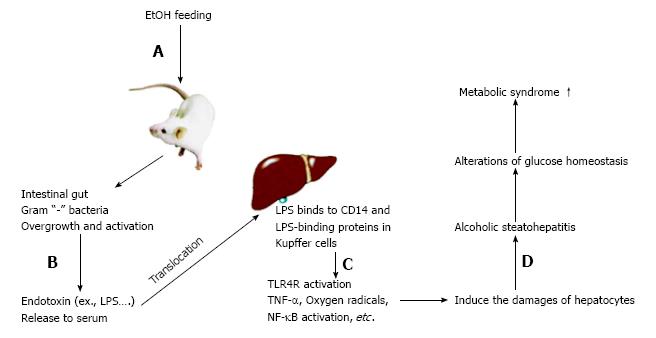Copyright
©The Author(s) 2015.
World J Biol Chem. Feb 26, 2015; 6(1): 1-15
Published online Feb 26, 2015. doi: 10.4331/wjbc.v6.i1.1
Published online Feb 26, 2015. doi: 10.4331/wjbc.v6.i1.1
Figure 1 Proposed model by which ethanol feeding induces hepatocyte damage.
A: Male 6-wk-old C57BL/6J mice (n = 8 in each group) were fed an ethanol diet for 8 wk. Individually caged mice were placed on a Lieber-Decarli regular liquid diet (Dyets; control diet: #710027, or ethanol diet: #710260). Mice were pair-fed with the control vs the 5% (v/v) ethanol diet for 8 wk; B: Alcohol intake induces the overgrowth and activation of intestinal gram-negative bacteria and subsequently increases the production of endotoxin (lipopolysaccharide, LPS) and its release into the blood; C: Released LPS activates toll-like receptor 4 (TLR4) on Kupffer cells, which are predominantly distributed in the lumen of hepatic sinusoids and exhibit endocytic activity against blood-borne materials entering the liver; D: Activated TLR4 drives Kupffer cells to produce inflammatory cytokines, chemokines, and reactive oxygen species via NF-kB activation, initiating an inflammatory cascade and hepatocyte damage.
- Citation: Kim JY, Lee DY, Lee YJ, Park KJ, Kim KH, Kim JW, Kim WH. Chronic alcohol consumption potentiates the development of diabetes through pancreatic β-cell dysfunction. World J Biol Chem 2015; 6(1): 1-15
- URL: https://www.wjgnet.com/1949-8454/full/v6/i1/1.htm
- DOI: https://dx.doi.org/10.4331/wjbc.v6.i1.1









